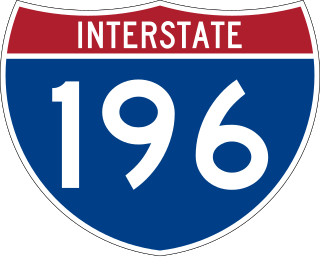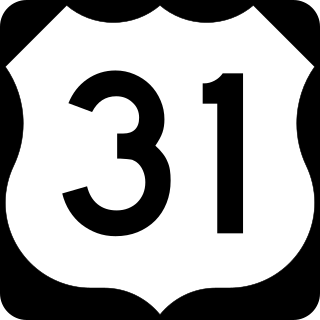Related Research Articles

Interstate 196 (I-196) is an auxiliary Interstate Highway that runs for 80.6 miles (129.7 km) in the US state of Michigan. It is a state trunkline highway that links Benton Harbor, South Haven, Holland, and Grand Rapids. In Kent, Ottawa, and Allegan counties, I-196 is known as the Gerald R. Ford Freeway, or simply the Ford Freeway, after President Gerald Ford, who was raised in Grand Rapids and served Michigan in the House of Representatives for 25 years. This name generally refers only to the section between Holland and Grand Rapids. I-196 changes direction; it is signed as a north–south highway from its southern terminus to the junction with US Highway 31 (US 31) just south of Holland, and as an east–west trunkline from this point to its eastern terminus at an interchange with I-96, its parent highway. There are three business routes related to the main freeway. There are two business loops and one business spur that serve South Haven, Holland and the Grand Rapids areas. Another business spur for Muskegon had been designated relative to the I-196 number.

West Michigan and Western Michigan are terms for a region in the U.S. state of Michigan's Lower Peninsula. Generally, it refers to the Grand Rapids-Muskegon-Holland area, and more broadly to most of the region along the Lower Peninsula's Lake Michigan shoreline, but there is no official definition.
The Lake Shore and Michigan Southern Railway, established in 1833, and sometimes referred to as the Lake Shore, was a major part of the New York Central Railroad's Water Level Route from Buffalo, New York, to Chicago, Illinois, primarily along the south shore of Lake Erie and across northern Indiana. The line's trackage remains a major rail transportation corridor used by Amtrak passenger trains and several freight lines; in 1998, its ownership was split at Cleveland, Ohio, between CSX Transportation to the east and Norfolk Southern Railway in the west.

The Grand Trunk Western Railroad Company was an American subsidiary of the Grand Trunk Railway, later of the Canadian National Railway operating in Michigan, Illinois, Indiana, and Ohio. Since a corporate restructuring in 1971, the railroad has been under CN's subsidiary holding company, the Grand Trunk Corporation. Grand Trunk Western's routes are part of CN's Michigan Division. Its primary mainline between Chicago and Port Huron, Michigan serves as a connection between railroad interchanges in Chicago and rail lines in eastern Canada and the Northeastern United States. The railroad's extensive trackage in Detroit and across southern Michigan has made it an essential link for the automotive industry as a hauler of parts and automobiles from manufacturing plants.

The Grand Rapids and Indiana Railroad at its height provided passenger and freight railroad services between Cincinnati, Ohio, and the Straits of Mackinac in Michigan, USA. The company was formed on January 18, 1854.

US Highway 31 (US 31) is a part of the United States Numbered Highway System that runs from Alabama to the Lower Peninsula of the US state of Michigan. In Michigan, it is a state trunkline highway that runs from the Indiana–Michigan state line at Bertrand Township north to its terminus at Interstate 75 (I-75) south of Mackinaw City. Along its 355.2-mile-long (571.6 km) route, US 31 follows the Michigan section of the St. Joseph Valley Parkway as well as other freeways and divided highways northward to Ludington. North of there, the trunkline is a rural undivided highway through the Northern Michigan tourist destinations of Traverse City and Petoskey before terminating south of Mackinaw City. Along its route, US 31 has been dedicated in memory of a few different organizations, and sections of it carry the Lake Michigan Circle Tour (LMCT) moniker. Four bridges used by the highway have been recognized for their historic character as well.

Railroads have been vital in the history of the population and trade of rough and finished goods in the state of Michigan. While some coastal settlements had previously existed, the population, commercial, and industrial growth of the state further bloomed with the establishment of the railroad.
The Flint and Pere Marquette Railroad (F&PM) is a defunct railroad which operated in the U.S. state of Michigan between 1857 and 1899. It was one of the three companies which merged to become the Pere Marquette Railway.
The Detroit, Lansing and Northern Railroad (DL&N) is a defunct railroad which was formed on December 27, 1876 as a reorganization of the foreclosed Detroit, Lansing and Lake Michigan Rail Road. The segment of its main line from Detroit to Lansing became an important component of the Pere Marquette Railroad, organized in 1900, and is still in use by CSX.
The Chicago and West Michigan Railway (C&WM) is a defunct railroad which operated in the state of Michigan between 1881 and 1899. It was one of the three companies which merged to become the Pere Marquette Railway.
The Michigan Lake Shore Railroad (MLS) is a defunct railroad company which operated in the state of Michigan between 1869 and 1878 and was known as the Grand Haven Railroad until 1881.
The Grand Rapids, Newaygo and Lake Shore Railroad is a defunct railroad which operated in the state of Michigan between 1872 and 1881. The GRN&LS was chartered on September 11, 1869, under the leadership of David P. Clay. The company operated a 46-mile (74 km) line between Grand Rapids and White Cloud. The initial segment, from Grand Rapids to Sparta, was completed on May 19, 1872. The line reached Newaygo on September 11, 1872; the first passenger train between the two towns ran the same day, to much fanfare from the local populace. On September 24, 1875, the line was extended over the Muskegon River to White Cloud. On September 30, 1881, it consolidated with other companies to form the Chicago & West Michigan. During its twelve years of independent existence the company sustained a net loss of $36,554.28.
The Ionia and Lansing Rail Road is a defunct railroad which operated in the state of Michigan in the 1860s and 1870s. The company incorporated on November 13, 1865; the investors hailed primarily from Lansing, Ionia and Portland. The original charter called for a 34-mile (55 km) line from Ionia to Lansing; on January 13, 1869 this was amended with a much grander vision: a 125-mile (201 km) line from Lansing to the mouth of the Pentwater River at Pentwater, on the shores of Lake Michigan.
The Grand Rapids and Lake Shore Railroad Company was organized to build a railroad from Grand Rapids to Pentwater, Michigan. The corporation was organized by Lowell Hall and other Grand Rapids businessmen. The company's bonds of $16,000 per mile were endorsed by the Michigan Central Railroad in January 1870, and much of the early construction was performed by Michigan Central crews treating it as an extension of that company's Grand River Valley branch. By May, officials had extended their plans to build to Manistee, and the company projected construction reaching Pentwater by November. Track was completed between Nunica and Muskegon in 1870.

There have been seven business routes of US Highway 31 in the state of Michigan. All of the business routes are former sections of US Highway 31 (US 31). They connect the freeway mainline of US 31 to the various downtowns of cities bypassed by US 31. Two of the current business routes, for Hart and Ludington, are business spurs, connecting to US 31 on only one end, while the remainder for Muskegon, Whitehall–Montague and Pentwater, are business loops. The two former routes, for Niles and Holland were a business spur and loop, respectively.
The Northern Central Michigan Railroad (NCMR) was a railroad line in the U.S. state of Michigan. The line ran from Lansing to Jonesville, then returned north from Jonesville to Albion and Eaton Rapids before closing the loop in Lansing. The NCMR had a short life as an independent company, becoming part of the Lake Shore and Michigan Southern Railway in 1871 and then consolidating with the New York Central Railroad in 1914.

The Union Depot is a railway station located at 610 Western Avenue in Muskegon, Michigan. It was listed on the National Register of Historic Places in 2000. It is now the Muskegon County Convention & Visitor's Bureau.

The Grand Rapids Subdivision is a railroad line in Western Michigan and Northern Indiana. It runs 136 miles (219 km) from Porter, Indiana to Grand Rapids, Michigan. It was built between 1870–1903 by the Chicago and Michigan Lake Shore Railroad and its successor the Pere Marquette Railroad. CSX Transportation owns the line today. In addition to freight traffic, the line hosts Amtrak's daily Pere Marquette.
The Hamilton Northwestern Railroad is a shortline railroad in West Michigan. It began operations in 2022 after purchasing the railroad from Endeavour Ag and Energy. That company's predecessor had purchased the recently abandoned railroad from CSX Transportation in 2003 to preserve rail service at their Hamilton location.
References
- 1 2 Michigan Railroad Commission (1878). Annual Report. p. 38.
- 1 2 Ivey, Paul (1919). The Pere Marquette Railroad Company. Lansing, MI: Michigan Historical Commission. pp. 35–39. OCLC 66109442.